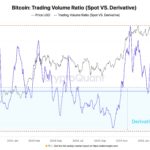
Bitcoin Price Surge Fueled by ETF Interest Amid Weak Stablecoin Purchasing Power
The exchange stablecoins ratio (ESR) and the stablecoin supply ratio (SSR) play a crucial role in understanding Bitcoin’s liquidity and its potential purchasing capability. The ESR indicates the ratio of stablecoins to Bitcoin held in exchange reserves, acting as an indicator of immediate liquidity in the market.
A low ESR suggests that immediate purchasing power is constrained, while a high ESR signifies a substantial amount of capital poised to enter Bitcoin. The SSR compares Bitcoin’s market capitalization with the total supply of stablecoins, reflecting the dynamics of demand driven by stablecoins. Together, these metrics offer a comprehensive view of liquidity support affecting Bitcoin’s price.
In 2025, the ESR continued its downward trajectory, reinforcing a trend that emerged in 2023. By early April, the ESR was approximately 0.000056 and dropped to about 0.000053 by the end of the month. These figures represent some of the lowest ESR levels recorded, indicating a scarcity of stablecoins in relation to Bitcoin reserves available on exchanges. Typically, markets with a low ESR are at an increased risk for downward fluctuations and struggle to support significant price increases without fresh capital injections.
During April, the stablecoin supply ratio saw a considerable rise. SSR escalated from 12.8 at the month’s start to 15.9 by the end, returning to levels reminiscent of February. This surge indicated a decline in the purchasing power of stablecoins compared to Bitcoin’s overall market cap. A heightened SSR has historically been linked to a diminished capacity for stablecoin flows alone to fuel significant price surges. The stagnant SSR throughout April reinforced the idea that the price rally surpassing $90,000 lacked robust stablecoin inflows or new speculative interest from cash reserves.
Notably, Bitcoin’s price maintained stability between $91,000 and $95,000 throughout April, closing near the higher end at approximately $95,000. This price steadiness, despite the lack of strong stablecoin backing, suggests that other factors contributed to the market’s strength. Absent substantial inflows of stablecoins, Bitcoin’s stability likely arose from increased ETF investments and long-term holders easing their selling pressure.
The interaction between ESR, SSR, and Bitcoin’s spot price illustrates a market environment limited by supply instead of being driven by fresh demand. A declining ESR constrained the ability of stablecoins to push prices upward.
A persistently elevated SSR indicated that the wider stablecoin ecosystem was not growing rapidly enough to significantly boost Bitcoin’s price. Nevertheless, BTC continued to climb, indicating a shift in market support towards institutional players, ETFs, and a reduction in sell-side liquidity rather than the emergence of new buyers.
April saw no significant uptick in stablecoin inflows to exchanges. Similarly, SSR remained stable without dipping, which might have signaled heightened stablecoin-driven purchasing ability. Retail demand via stablecoins appeared to be lacking, suggesting that Bitcoin’s endurance was backed by factors beyond stablecoin liquidity, with ETF allocations and passive spot purchases playing a critical role.
The combination of low ESR and high SSR indicates that Bitcoin’s price was primarily sustained by existing spot demand, ETF flows, or long-term holders decreasing their selling activity, rather than an influx of new stablecoin liquidity typically characteristic of robust retail-driven rallies.
Throughout April, there were no indications of a significant short-term inflow of new capital via stablecoins. Should Bitcoin attempt to surpass $95,000, the prevailing market conditions would necessitate increased external purchases, such as additional ETF contributions or direct fiat inflows, or a sudden rise in stablecoin deposits to exchanges.



















Post Comment